



Stinging insects such as wasps and bees are common in most parts of the world and that includes here in West Texas. They
have similar appearances and coloring, yet are different in many ways. Wasps feed mostly on soft-bodied insects, especially
caterpillars which they will feed to their young, bees mostly feed on a mixture of pollen and nectar. Wasps have smooth bodies
as opposed to bees that have hairy bodies. Wasps and can sting repeatedly without dying as opposed to bees which will only
sting once and then die. A sting from any one of these insects can be very painful and could pose a life-threatening danger to
those who are allergic to them. Let the professionals take care of these insects by Contacting Southwestern A-1 Pest Control
to make an appointment.
Paper Wasp
Paper Wasp are about 3/4 of an inch long and are black, brown, or reddish in
color with bright yellow markings. They have long droopy legs that hang below
them as they fly. They nest in colonies of up to several dozen wasps. Their nests
are typically small, attached by a single stalk to an overhanging support, and
have a single comb of cells. They construct these nests made of a gray papery
material by gathering fibers from dead pieces of wood and plant stems and
mixing it with their saliva. They usually build their nests in areas which are
secluded and quiet, most often choosing man-made structures such as
underneath porches, in hollow metal fence posts and PVC furniture, on
playground equipment, light fixtures, under deck railings, on window and door
frames or underneath the eaves of homes. Other nesting locations may include
trees and shrubs.
The Paper Wasp is not overly aggressive in nature but can sting and will defend their nest if disturbed. They may also become
defensive when they are away from their nest if a peson swats at them. The Paper Wasp is capable of inflicting multiple stings at
a time. They can become a nuisance when they nest around homes, recreational facilities, or other human-occupied areas.
Yellow Jackets
Yellow Jackets are members of the wasp family. They are are approximately 1/2
to 3/4 of an inch in length as adults and have a very distinctive black & yellow,
striped abdomen. They are social insects who live in large colonies. In warmer
climates such as ours in Texas, yellow jacket colonies can survive for several
years, and the number of wasps in a colony can reach several thousand. Yellow
jackets are primarily carnivorous, eating other insects and scavenging for animal
carcasses, but they also will readily drink nectar, soft drinks, and other sugary
fluids. They are common pests in and around parks, picnic areas, swimming
pools, golf courses, campsites and suburban areas where people leave open
food and discarded garbage.
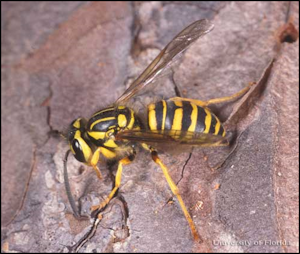
Yellow Jackets usually build their nests either underground or in hollow trees or other naturally-occurring voids. They will also
build nests in structural voids of buildings, roof soffits, crawl spaces, playground equipment, and pretty much any other hollow
object they can find. They construct their nests of a paper-like material consisting of wood fiber. Unlike paper wasp nests, they
are completely enclosed in an envelope except for the entrance hole. nest size may vary from a few inches to 6 feet or larger,
and nests may contain up to 45 levels of combs and 20,000 adult workers. Yellow Jackets are primarily ground nesters, but also
construct aerial nests. Subterranean nests may be found in gardens, flower beds, pastures, roadside embankments and
elsewhere. Aerial nests are typically constructed in trees, under eaves, in wall voids of buildings, in open garages and storage
sheds, on porches, in abandoned furniture and in other places that provide protection and are close to food and water.
Yellow Jackets are very aggressive and are capable of inflicting multiple, painful stings. They will attack if their nest is disturbed
or if they feel threatened. The yellow jacket is often mistaken to be an Africanized Honey Bee due to their aggressive behavior
especially around their nest where they will readily mount an attack if the colony is disturbed.
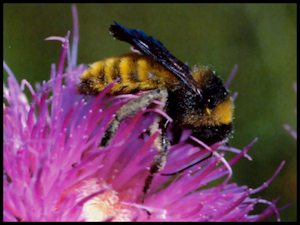
Bumble Bees
Bumble bees are fairly easy to recognize due to thier large bulky, hairy bodies. They
are about 3/4 inches long and usually black with yellow or orangish patterns on their
abdomens.
They can often be seen buzzing around flowers feeding on nectar. They actually
gather nectar to make honey, however, they do not produce nearly as much as honey
bees.
Bumble bees are not generally aggressive unless they feel threatened or feel a need
to defend their nest. They really only become a problem when their nest is located
next to a home, building or walkway.
They tend to build fairly simple and disorganized nests using grass clippings, piles of dried leaves, porch furniture cushions,
insulation, or other loose “fluffy” material. They may also nest underground or under exterior concrete slabs such as patios or
sidewalks.
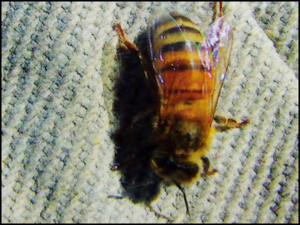
Honey Bees
The Honey Bee is one of the most beneficial insects on the planet. For centuries,
beekeepers have raised them for commercial use, harvesting the sweet honey
they produce and relying on them to pollinate crops. Their role in pollination is
vital to many types of fruit and vegetable crops.
Honey Bees represent a highly organized society, with various bees having very
specific roles during their lifetime. Roles involved in a colony of Honey Bees
include: nurses, guards, grocers, housekeepers, construction workers, royal
attendants and undertakers.
They colonize in hives and are capable of producing massive nests containing tens of thousands of workers and weighing
hundreds of pounds. Most Honey Bee colonies are not pests, yet if they build their hive in close proximity to humans or when the
hive is in the walls of a home or business, then they can become a real problem. The hive is usually not visible, however, their
presence will be known by the flying in and out at some small gap, crack, or opening on the exterior of a house or business.
Honeybees are not aggressive by nature, and will not sting unless provoked or when protecting their hive from an intruder. If
provoked or threatened, they indeed may deliver a sting, however they will only sting once and then die. A honey bee will leave its
stinger in your skin and the sooner you remove it the sooner the pain will diminish. Placing ice on a sting can help to reduce the
swelling.
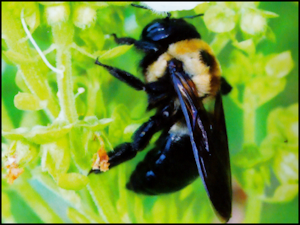
Carpenter Bees
Carpenter bees are large, black and yellow bees frequently seen in spring
hovering around the eaves of a house or the underside of a deck or porch rail.
They are most often mistaken for bumble bees, but differ in that they have a black
shiny tail section.The carpenter bee is so-called because of its habit of excavating
tunnels in wood with its strong jaws.
While carpenter bees are considered “wood-destroying” insects, the damage they
do is typically limited to surface wood and they are not likely to do any damage to
the structural or weight bearing wood of a house. They do not eat the wood but
rather make tunnels through it in which to lay eggs and raise young.
Carpenter bees are solitary insects, but they will often nest in close proximity to other carpenter bees.
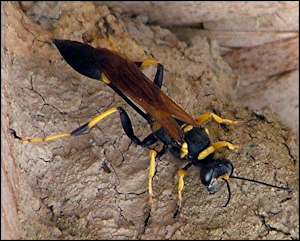
Mud Duaber
Mud daubers are a species of wasp and are found throughout the United States.
They are also common right here in West Texas.
Unlike bees and other wasps who live in colonies, Mud Daubers are solitary wasps
that get there name from the fact that they construct their nest out of mud. They will
build small nests of mud in the shape of long parallel tubes underneath overhangs
and eaves of buildings, homes, sheds or barns.
These wasps are long and slender with a narrow, thread-like waist The adult Mud
Daubers are 3/4 to 1 inch long and vary in color from dull black to black with bright
yellow markings. Some are a solid steel blue to bluish-black.
The Mud Duaber is quite intimidating in appearance and tends to evoke a great deal of anxiety and fear in people, however,
although the Mud Duaber is capable of stinging, they are very seldom aggressive and rarely do.
Control of these insects is not warranted since they normally pose little threat to humans or property, Rather, mud daubers
should be regarded as beneficial, since they remove and use as prey many species of spiders which most people find
disagreeable.

WASPS & BEES
Listed below are a few of the more common flying pests in our local area:
LEARNING CENTER




